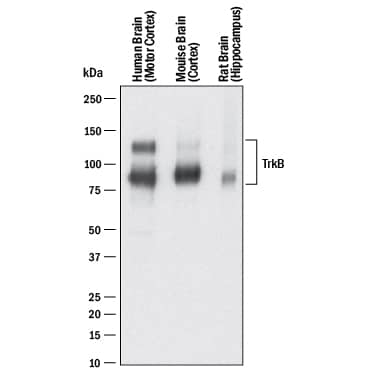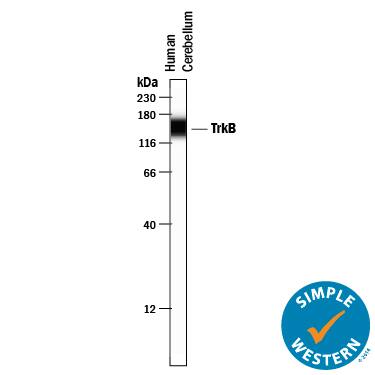Human/Mouse/Rat TrkB Antibody
R&D Systems, part of Bio-Techne | Catalog # AF397


Key Product Details
Species Reactivity
Validated:
Cited:
Applications
Validated:
Cited:
Label
Antibody Source
Product Specifications
Immunogen
Specificity
Clonality
Host
Isotype
Scientific Data Images for Human/Mouse/Rat TrkB Antibody
Detection of Human TrkB by Western Blot.
Western blot shows lysates of human brain (motor cortex) tissue, human brain (cerebellum) tissue, and human brain (hypothalamus) tissue. PVDF membrane was probed with 0.5 µg/mL of Goat Anti-Human/Mouse/Rat TrkB Antigen Affinity-purified Polyclonal Antibody (Catalog # AF397) followed by HRP-conjugated Anti-Goat IgG Secondary Antibody (HAF017). Specific bands were detected for TrkB at approximately 90-100 & 140 kDa (as indicated). This experiment was conducted under reducing conditions and using Immunoblot Buffer Group 1.Detection of Human, Mouse, and Rat TrkB by Western Blot.
Western blot shows lysates of human brain (motor cortex) tissue, mouse brain (cortex) tissue, and rat brain (hippocampus) tissue. PVDF membrane was probed with 0.25 µg/mL of Goat Anti-Human/Mouse/Rat TrkB Antigen Affinity-purified Polyclonal Antibody (Catalog # AF397) followed by HRP-conjugated Anti-Goat IgG Secondary Antibody (HAF017). Specific bands were detected for TrkB at approximately 95 kDa and 145 kDa (as indicated). This experiment was conducted under reducing conditions and using Immunoblot Buffer Group 1.Detection of Human TrkB by Simple WesternTM.
Simple Western lane view shows lysates of human brain (cerebellum) tissue, loaded at 0.2 mg/mL. A specific band was detected for TrkB at approximately 162 kDa (as indicated) using 10 µg/mL of Goat Anti-Human/Mouse/Rat TrkB Antigen Affinity-purified Polyclonal Antibody (Catalog # AF397) followed by 1:50 dilution of HRP-conjugated Anti-Goat IgG Secondary Antibody (HAF109). This experiment was conducted under reducing conditions and using the 12-230 kDa separation system.Applications for Human/Mouse/Rat TrkB Antibody
CyTOF-ready
Flow Cytometry
Sample: Baf3 cells transfected with Human TrkB vs Irrelevant transfectant cells
Simple Western
Sample: Human brain (cerebellum) tissue
Western Blot
Sample: Human brain (motor cortex) tissue, human brain (cerebellum) tissue, and human brain (hypothalamus) tissue, mouse brain (cortex) tissue, and rat brain (hippocampus) tissue
Formulation, Preparation, and Storage
Purification
Reconstitution
Formulation
Shipping
Stability & Storage
- 12 months from date of receipt, -20 to -70 °C as supplied.
- 1 month, 2 to 8 °C under sterile conditions after reconstitution.
- 6 months, -20 to -70 °C under sterile conditions after reconstitution.
Background: TrkB
The neurotrophins, including NGF, BDNF, NT-3, and NT-4/5 constitute a group of structurally related, secreted proteins that play an important role in the development and function of the nervous system. The biological activities of the neurotrophins are mediated by binding to the different members of the Trk family tyrosine kinase receptors. Three Trk family proteins, TrkA, TrkB, and TrkC, exhibiting different ligand specificities, have been identified. TrkA binds NGF, TrkB binds BDNF and NT-4/5 and TrkC binds NT-3. All Trk family proteins share a conserved complex subdomain organization consisting of a signal peptide, two cysteine-rich domains, a cluster of three leucine-rich motifs, and two immunoglobulin-like domains in the extracellular region, as well as an intracellular region that contains the tyrosine kinase domain. Natural splice variants of the different Trks, including TrkB variants lacking the first cysteine-rich domain, the first and second or all three of the leucine-rich motifs, or the tyrosine kinase domain, have been described. The role of the different extracellular subdomains of TrkB in mediating neurotrophin binding and discrimination is currently being investigated. At the protein sequence level, human and rat TrkB are greater than 90% identical and the proteins exhibit cross-species activity. TrkB is primarily expressed in the nervous system. However, low levels of TrkB expression have also been observed in a wide variety of tissues (pancreas, kidneys, ovary) outside the nervous system.
References
- Ninkina, N. et al. (1997) J. Biol. Chem. 272:13019.
- Middlemas, D.S. et al. (1991) Mol. Cell Biol. 11:143.
- Soppet, D. et al. (1991) Cell 65:895.
Long Name
Alternate Names
Gene Symbol
Additional TrkB Products
Product Documents for Human/Mouse/Rat TrkB Antibody
Product Specific Notices for Human/Mouse/Rat TrkB Antibody
For research use only


